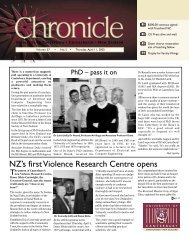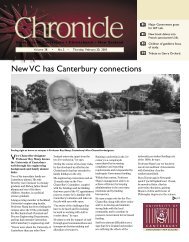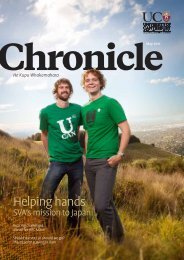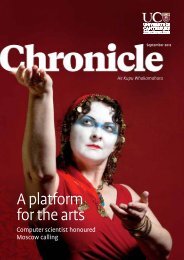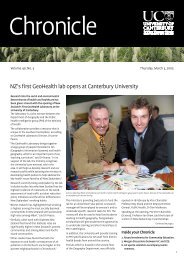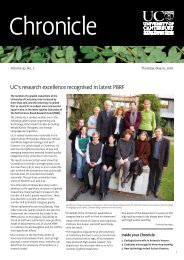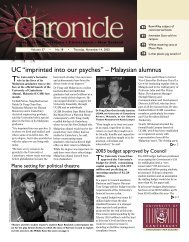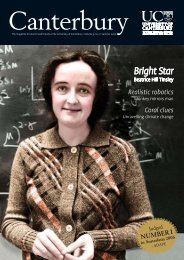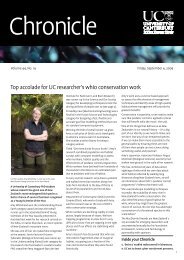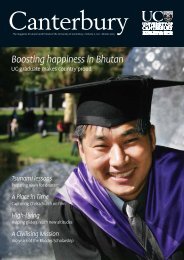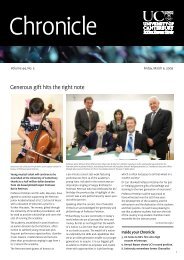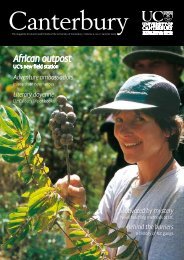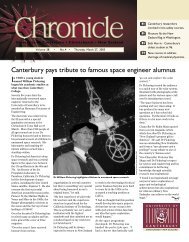No 11 July 18 2002 - Communications - University of Canterbury
No 11 July 18 2002 - Communications - University of Canterbury
No 11 July 18 2002 - Communications - University of Canterbury
Create successful ePaper yourself
Turn your PDF publications into a flip-book with our unique Google optimized e-Paper software.
Mech Engineering puts rugby balls through their paces<br />
With the international<br />
rugby season upon us,<br />
rugby becomes a serious<br />
occupation for some –<br />
including those in the<br />
Mechanical Engineering<br />
Department.<br />
TV3 contracted the department<br />
to conduct a number <strong>of</strong> trials on<br />
the two brands <strong>of</strong> rugby ball<br />
available, Adidas and Gilbert. A<br />
documentary on the balls was<br />
aired on TV3 last Friday night<br />
(<strong>July</strong> 12), the night before the<br />
Tri-Nations Bledisloe Cup game<br />
against Australia at Jade Stadium.<br />
“There has been a lot <strong>of</strong><br />
controversy over the balls,”<br />
Graeme Harris, Mechanical<br />
Engineering aeronautics<br />
technical <strong>of</strong>ficer, said. “Some say<br />
the Adidas ball doesn’t fly as well<br />
in the air, so when kicked it could<br />
be less accurate. As the All<br />
Blacks are used to the Adidas<br />
ball, it may give them an<br />
advantage over visiting teams.<br />
We wanted to see if the balls<br />
were in fact different and if the<br />
hearsay was true.”<br />
Dr Dave Aitchison, a lecturer in<br />
sports engineering, has also been<br />
involved in the testing and<br />
analysis programming.<br />
The work <strong>of</strong> one <strong>of</strong> the 20th<br />
century’s greatest philosophers,<br />
Sir Karl Popper, was celebrated<br />
in Christchurch last weekend,<br />
100 years since his birth in<br />
Austria.<br />
Karl Popper lectured at what was<br />
then <strong>Canterbury</strong> <strong>University</strong> College<br />
from 1937 to 1945 and during this<br />
period wrote what is arguably his<br />
most influential work, The Open<br />
Society and Its Enemies.<br />
It is widely acknowledged that the<br />
ideas contained in Open Society<br />
provided the philosophical basis<br />
that successfully challenged<br />
communism and led to the eventual<br />
democratisation <strong>of</strong> Eastern and<br />
Central Europe.<br />
Popper came to <strong>Canterbury</strong> in 1937<br />
with his wife Hennie and engaged<br />
in a huge range <strong>of</strong> teaching and<br />
exposition, fundamentally changing<br />
the <strong>University</strong>’s thinking on<br />
research and the nature <strong>of</strong><br />
<strong>University</strong> <strong>of</strong> <strong>Canterbury</strong> Chronicle<br />
During an investigation which<br />
lasted more than three weeks,<br />
the balls were tested and<br />
measured according to the<br />
international rugby ball<br />
standards for more than 15<br />
variables, including mass,<br />
dimensions, inertia, stability,<br />
aerodynamic ability and weight.<br />
But Mr Harris said more could<br />
be done. “There is enough work<br />
to do a PhD thesis on the subject<br />
if someone wanted to - it is a<br />
complex topic.”<br />
The Mechanical Engineering<br />
Department was chosen to<br />
complete the testing because it<br />
specialised technical equipment<br />
enables the balls to be measured<br />
under stringent conditions. Of<br />
the technical equipment, the<br />
computer co-ordinate measuring<br />
machine measured the<br />
dimensions <strong>of</strong> the balls down to<br />
microns. Testing has also been<br />
carried out in the department’s<br />
wind tunnel. The ball is passed<br />
into the tunnel and the flight path<br />
and the air flow around the ball is<br />
recorded on video and analysed.<br />
“The testing isn’t to determine<br />
which ball is better. It was to see<br />
if there were differences in the<br />
two models <strong>of</strong> rugby ball. It was<br />
academic work. He also climbed<br />
Mount Cook. Sir Karl died in 1994.<br />
The <strong>University</strong> <strong>of</strong> <strong>Canterbury</strong>’s<br />
Popper Centenary Conference last<br />
weekend at Chateau on the Park<br />
attracted leading Popper experts<br />
from New Zealand and around the<br />
world. These included Dr Alan<br />
Ryan, Master <strong>of</strong> New College Oxford<br />
and author <strong>of</strong> books on political<br />
philosophy and the philosophy <strong>of</strong><br />
social science, and Dr Anthony<br />
O’Hear from the <strong>University</strong> <strong>of</strong><br />
Bradford, the Director <strong>of</strong> the Royal<br />
Institute <strong>of</strong> Philosophy and author<br />
and editor <strong>of</strong> books on Popper.<br />
Topics covered included “Science<br />
and Democracy”, “Popper and<br />
Analytical Philosophy”, “Popper’s<br />
Utopia” and “Towards an Open<br />
Knowledge Society”.<br />
The conference was organised by<br />
staff from the Philosophy and<br />
Religious Studies, and Political<br />
Science, departments.<br />
The computer co-ordinate measuring machine shows the Gilbert ball is shorter<br />
than the Adidas one.<br />
Wind blowing (from left to right) in the wind tunnel leaves patterns on the<br />
Gilbert ball (left) and the Adidas ball, which are recorded for later analysis.<br />
interesting to see that both balls<br />
had significant differences. The<br />
dimensions were slightly<br />
different – one ball was 20g<br />
heavier than the other and one<br />
Christchurch hosts conference on leading 20 th Century philosopher<br />
ball is bigger, one was shorter –<br />
overall they were significantly<br />
different,” Mr Harris said.<br />
Jane Lucas<br />
Reminiscing about Popper are, from left, Pr<strong>of</strong>essor Peter Munz, a <strong>Canterbury</strong><br />
<strong>University</strong> College student in the 1940s, Popper book author and Visiting Erskine<br />
Fellow Pr<strong>of</strong>essor Anthony O’Hear, and Jeremy Shearmur, a student <strong>of</strong>, and<br />
assistant to, Popper while he was at <strong>Canterbury</strong>.<br />
Photos by Graeme Harris, Mech Eng. Dept.<br />
Photo by Duncan Shaw-Brown, C&D



